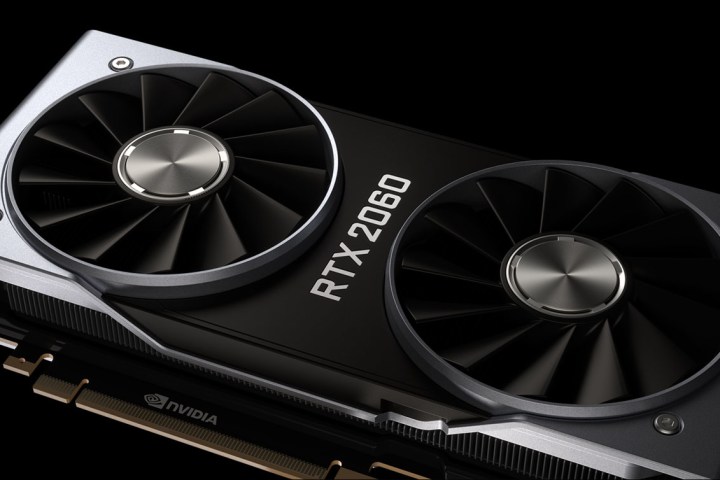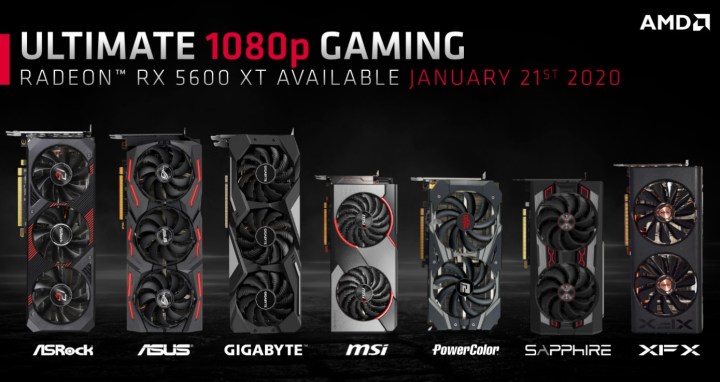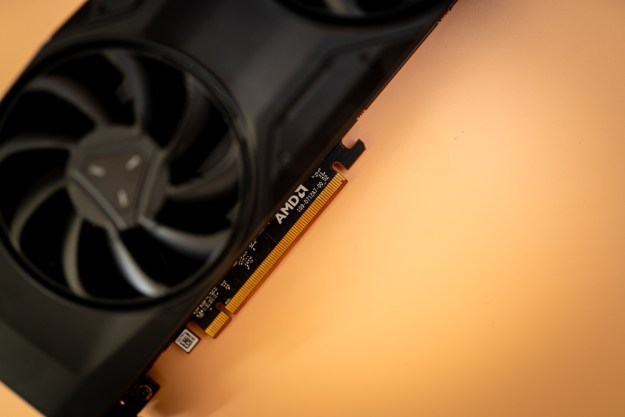According to Steam’s August 2020 hardware stats, over 60% of PC gamers play at 1080p. The next most popular resolution is 1366 x 768 at around 9% of the market, with 1440p following with around 6% of the market. 1080p is king, and — ignoring Nvidia’s new 30-series and AMD’s 6000-series GPUs — three of the best options for that resolution are the AMD RX 5600 XT, Nvidia RTX 2060, and GTX 1660 Ti.
When it comes to price, each of these cards clocks in around $300, but there are some reasons to consider one over the other. In this guide, we’ll run down everything you need to know before picking one up.
If $300 is above or below your budget, check out our list of the best graphics cards available now.
Pricing and availability

The Nvidia RTX 2060 is the oldest card in this lineup, debuting in January 2019. Its price stayed very close to what it launched at until the 5600 XT crested the horizon. It has since been dropped to $300, a sizable cut that makes the 2060 a much more competitive option. Not all third parties have followed suit, however, so some cards are still found between $320 and $340.
The GTX 1660 Ti debuted just over a month later, in late February 2019, with a price of $279 for the Founders Edition. In late 2020, there are still third-party options available around that price. Some cards, such as the MSI Ventus XS, have dropped as low as $220.
The AMD RX 5600 XT made its grand entrance in January 2020 following a CES unveiling. It has no reference version from AMD, so although some third-party cards are sold at its reference price of $280, more are sold between $290 and $320, depending on their cooling configuration.
Right now, all three cards are around the same price as when they launched. The 1660 Ti is the cheapest of the lot, with options shy of $250, though all three models usually sell for around $300. Availability isn’t an issue, either. Nvidia’s two offerings are the most plentiful, though we still found multiple 5600 XTs in stock at various online retailers. There are even more options on the secondhand market, especially with the impending launch of the RTX 3000 series. As of late 2020, though, secondhand prices are only around $50 less.
If you’re planning on buying one of these cards, it’s best to do so now. The RTX 3080, once it restocks, should mark the end of life for Nvidia’s 10-series and 20-series GPUs. Stock is high at the moment, but it’s likely that whatever retailers have on-hand is the last they’ll have.
Performance

With prices so close to one another, the kind of frame rates and detail settings you can expect to play at with these cards is extremely important. All three are excellent at 1080p gaming, but which is the most powerful?
| RX 5600 XT* | RTX 2060 | GTX 1660 Ti | |
| Process node | 7nm | 12nm | 12nm |
| Graphics cores | 2,304 stream processors | 1,920 CUDA cores | 1,536 CUDA cores |
| RT Cores | N/A | 30 | N/A |
| Tensor Cores | N/A | 240 | N/A |
| Base clock | N/A | 1,365MHz | 1,500MHz |
| Game clock | 1,615MHz | N/A | N/A |
| Boost clock | 1,750MHz | 1,680MHz | 1,770MHz |
| Memory | 6GB GDDR6 | 6GB GDDR6 | 6GB GDDR6 |
| Memory speed | 14Gbps | 14Gbps | 12Gbps |
| Bandwidth | 336GBps | 336GBps | 288GBps |
| TDP | 160w | 160w | 120w |
*AMD released a BIOS update for the 5600 XT shortly before launch, improving clock speeds for the core and memory. Most cards should have this applied, though not all will at launch.
It’s difficult to directly compare every aspect of graphics cards from different manufacturers, as their architectures are quite different, but there are some aspects we can pit against one another. The RTX 2060 has 25% more CUDA cores than the GTX 1660 Ti, which the slight clock speed disparity will not be able to close.
The memory configurations of the RX 5600 XT and the RTX 2060 are effectively identical after the AMD BIOS update, while the GTX 1660 Ti lags behind again with slower memory, despite having the same quantity. Overclocking may be able to fix that, but not always. You’d also likely be giving up your TDP advantage, with the 1660 Ti requiring significantly less cooling potential than the other two cards.
In the real world, Anandtech found the RX 5600 XT was just that little bit faster than the RTX 2060 (though not all versions could beat it). Even at 1080p, there were only a few frames between them. The GTX 1660 Ti lagged a little further behind the RTX 2060, suggesting that its price match with the RX 5600 XT might give it some serious problems moving forward.
Toms Hardware echoed these findings, with the RX 5600 XT pulling ahead of the RTX 2060 in almost all games it tested. In Gears of War 5 the difference was huge too, with a 15 FPS disparity on average, and more than 22 FPS for the 1% lows. There is some trading of blows, but ultimately the 5600 XT comes out ahead. Both cards demolish the GTX 1660 Ti, relegating it to a class well below them both and suggesting a price drop is very much needed.
Engadget’s results push the 5600 XT above even the near-$400 RTX 2060 Super, which seems a little anomalous, but shows just how capable the 5600 XT is. Engadget called it the best option for 1080p gaming at high frame rates, and most seem to agree.
Image sharpening, ray tracing, and more
The two big GPU manufacturers have some very different features to offer alongside their cards’ raw power. The AMD RX 5600 XT enjoys AMD’s image sharpening, Radeon Boost technology for enhanced FPS in high-speed games, and integer display scaling for beautifying pixilated games. There’s also lower latency inputs for faster competitive gaming, and an ever-expanding game streaming and recording service in ReLive.
Nvidia on the other hand, has its own image sharpening and low latency gaming features, but the big one that AMD can’t touch is ray tracing. The RTX 2060 has hardware accelerated ray tracing with its RT cores that the RX 5600 XT simply can’t do. The 1660 Ti can display ray tracing, but it doesn’t have the performance to make it comfortably playable, even at 1080p.
Nvidia has its own image sharpening and low latency gaming features. The most significant one is that AMD can’t touch is ray tracing. The RTX 2060 has hardware-accelerated ray tracing with its RT cores that the RX 5600 XT can’t do. The 1660 Ti can display ray tracing, but even at 1080p, it doesn’t have the performance to make it comfortably playable.
The RTX 2060 also supports deep learning super sampling; However, like ray tracing, there aren’t many games that support it as of yet.
The 5600 XT is the new 1080p king

It’s almost laughable that AMD has only just started launching 1080p gaming cards because their product is highly commendable. For the Digital Trends team, the RX 5600 is the go-to card for gamers. It outperforms the GTX 1660 Ti, and it’s, at minimum, on-par with the RTX 2060. A hail-mary BIOS update saved the card from becoming obsolete, but that likely won’t lead to any long-lasting concerns.
The RTX 2060 will cost you about $300; The GPU is still a viable option considering the cost, especially if you’re hoping to try ray tracing and DLSS. That said, the RX 5600 XT is a cheaper card, and you’ll find that you’re able to run 1080p games at a high frame rate too. The RTX 2060 appears like a next-generation Vega 56. The card is 1440p capable, but it probably won’t maintain its 60 FPS rate for most modern games.
Editors' Recommendations
- Nvidia RTX 50-series graphics cards: news, release date, price, and more
- This underrated AMD GPU beats the RTX 4070 Ti Super
- I tested AMD’s RX 7600 XT against the RTX 4060 — and I was shocked by the results
- RTX 4080 Super vs. RTX 4070 Ti Super vs. RTX 4070 Super: Nvidia’s new GPUs, compared
- AMD has another new GPU that it says can beat the RTX 4060 Ti





